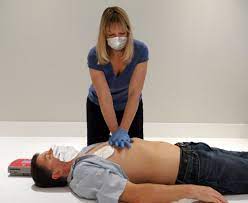Emergency Response


Performing CPR
Cardiopulmonary resuscitation (CPR) is a lifesaving technique that’s useful in many emergencies, such as a heart attack or near drowning, in which someone’s breathing or heartbeat has stopped. The American Heart Association recommends starting CPR with hard and fast chest compressions (100-120 compressions per minute). This hands-only CPR recommendation applies to both untrained bystanders and first responders.
If you’re afraid to do CPR or unsure how to perform CPR correctly, know that it’s always better to try than to do nothing at all. The difference between doing something and doing nothing could be someone’s life. (Mayo Clinic https://www.mayoclinic.org/first-aid/first-aid-cpr/basics/art-20056600)

Using a Defibrillator (AED) Automated External Defibrillator (AED)
AEDs are used to revive someone from sudden cardiac arrest.
If someone has fainted and might need an AED:
- Check to see if the person is breathing and has a pulse.
- If you cannot feel a pulse and the person is not breathing, call for emergency help (911). If there are other people present, one person can call 911 while the other prepares the AED. If you’re alone, call 911 or emergency services first to make sure help is on the way. If an AED is not immediately available start CPR.
- Turn on the AED. The automated external defibrillator gives you step-by-step voice instructions. It will tell you how to check for breathing and a pulse and how to position electrode pads on the person’s bare chest.
- Deliver the shock. When the pads are in place, the AED automatically measures the person’s heart rhythm and determines if a shock is needed. If it is, the machine tells the user to stand back as it charges and then tells you to push a button to deliver the shock. The AED is programmed not to deliver a shock if a shock isn’t needed. Not everyone in cardiac arrest benefits from a shock
- Start CPR. Begin CPR after the shock is delivered if CPR is still needed. The AED will also guide users through CPR. The process can be repeated as needed until emergency crews take over.
(Mayo Clinic https://www.mayoclinic.org/diseases-conditions/heart-arrhythmia/in-depth/automated-external-defibrillators/art-20043909)
